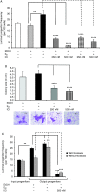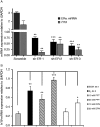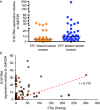Estrogen regulates luminal progenitor cell differentiation through H19 gene expression
- PMID: 25944846
- PMCID: PMC4498491
- DOI: 10.1530/ERC-15-0105
Estrogen regulates luminal progenitor cell differentiation through H19 gene expression
Abstract
Although the role of estrogen signaling in breast cancer development has been extensively studied, the mechanisms that regulate the indispensable role of estrogen in normal mammary gland development have not been well studied. Because of the unavailability of culture system to maintain estrogen-receptor-positive (ERα(+)) cells in vitro, the molecular mechanisms that regulate estrogen/ERα signaling in the normal human breast are unknown. In the present study, we examined the effects of estrogen signaling on ERα(+) human luminal progenitors using a modified matrigel assay and found that estrogen signaling increased the expansion potential of these progenitors. Furthermore, we found that blocking ERα attenuated luminal progenitor expansion and decreased the luminal colony-forming potential of these progenitors. Additionally, blocking ERα decreased H19 expression in the luminal progenitors and led to the development of smaller luminal colonies. We further showed that knocking down the H19 gene in the luminal progenitors significantly decreased the colony-forming potential of the luminal progenitors, and this phenotype could not be rescued by the addition of estrogen. Lastly, we explored the clinical relevance of the estrogen-H19 signaling axis in breast tumors and found that ERα(+) tumors exhibited a higher expression of H19 as compared with ERα(-) tumors and that H19 expression showed a positive correlation with ERα expression in those tumors. Taken together, the present results indicate that the estrogen-ERα-H19 signaling axis plays a role in regulating the proliferation and differentiation potentials of the normal luminal progenitors and that this signaling network may also be important in the development of ER(+) breast cancer tumors.
Keywords: ER+ breast cancer cells; ERα; H19; luminal progenitors.
© 2015 The authors.
Figures






Similar articles
-
Long Non-Coding RNA H19 Acts as an Estrogen Receptor Modulator that is Required for Endocrine Therapy Resistance in ER+ Breast Cancer Cells.Cell Physiol Biochem. 2018;51(4):1518-1532. doi: 10.1159/000495643. Epub 2018 Nov 29. Cell Physiol Biochem. 2018. PMID: 30497079
-
Cofactors of LIM Domains Associate with Estrogen Receptor α to Regulate the Expression of Noncoding RNA H19 and Corneal Epithelial Progenitor Cell Function.J Biol Chem. 2016 Jun 17;291(25):13271-85. doi: 10.1074/jbc.M115.709386. Epub 2016 Apr 29. J Biol Chem. 2016. PMID: 27129775 Free PMC article.
-
Prolactin-induced mouse mammary carcinomas model estrogen resistant luminal breast cancer.Breast Cancer Res. 2011 Jan 28;13(1):R11. doi: 10.1186/bcr2819. Breast Cancer Res. 2011. PMID: 21276249 Free PMC article.
-
Estrogens and their receptors in breast cancer progression: a dual role in cancer proliferation and invasion.Crit Rev Oncol Hematol. 2004 Jul;51(1):55-67. doi: 10.1016/j.critrevonc.2004.02.001. Crit Rev Oncol Hematol. 2004. PMID: 15207254 Review.
-
Derailed estrogen signaling and breast cancer: an authentic couple.Endocr Rev. 2013 Feb;34(1):1-32. doi: 10.1210/er.2011-1057. Epub 2012 Sep 4. Endocr Rev. 2013. PMID: 22947396 Free PMC article. Review.
Cited by
-
The long non-coding RNA H19: an active player with multiple facets to sustain the hallmarks of cancer.Cell Mol Life Sci. 2019 Dec;76(23):4673-4687. doi: 10.1007/s00018-019-03240-z. Epub 2019 Jul 23. Cell Mol Life Sci. 2019. PMID: 31338555 Free PMC article. Review.
-
A robust cell culture system for large scale feeder cell-free expansion of human breast epithelial progenitors.Stem Cell Res Ther. 2018 Oct 4;9(1):264. doi: 10.1186/s13287-018-0994-y. Stem Cell Res Ther. 2018. PMID: 30286804 Free PMC article.
-
Genetic variants in long noncoding RNA H19 contribute to the risk of breast cancer in a southeast China Han population.Onco Targets Ther. 2017 Sep 7;10:4369-4378. doi: 10.2147/OTT.S127962. eCollection 2017. Onco Targets Ther. 2017. PMID: 28919786 Free PMC article.
-
Epigenetics: New Insights into Mammary Gland Biology.Genes (Basel). 2021 Feb 5;12(2):231. doi: 10.3390/genes12020231. Genes (Basel). 2021. PMID: 33562534 Free PMC article. Review.
-
Cholangiocyte-derived exosomal long noncoding RNA H19 promotes cholestatic liver injury in mouse and humans.Hepatology. 2018 Aug;68(2):599-615. doi: 10.1002/hep.29838. Epub 2018 May 2. Hepatology. 2018. PMID: 29425397 Free PMC article.
References
-
- Adriaenssens E, Dumont L, Lottin S, Bolle D, Lepretre A, Delobelle A, Bouali F, Dugimont T, Coll J, Curgy JJ. H19 overexpression in breast adenocarcinoma stromal cells is associated with tumor values and steroid receptor status but independent of p53 and Ki-67 expression. American Journal of Pathology. 1998;153:1597–1607. doi: 10.1016/S0002-9440(10)65748-3. - DOI - PMC - PubMed
-
- Adriaenssens E, Lottin S, Berteaux N, Hornez L, Fauquette W, Fafeur V, Peyrat JP, Le Bourhis X, Hondermarck H, Coll J, et al. Cross-talk between mesenchyme and epithelium increases H19 gene expression during scattering and morphogenesis of epithelial cells. Experimental Cell Research. 2002;275:215–229. doi: 10.1006/excr.2002.5500. - DOI - PubMed
Publication types
MeSH terms
Substances
LinkOut - more resources
Full Text Sources
Medical
Miscellaneous

